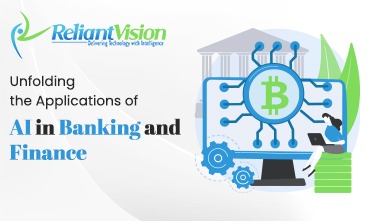Since its inception, AI has had a major effect on the way businesses, especially those in the banking and financial industry, function and provide services to their clients. Banking has become more customer-focused, all thanks to the use of AI in applications and services.
Banks have become more productive and can make judgments based on data that would be incomprehensible to a person. In addition, sophisticated algorithms can detect false data in a flash.
Reports claim that approximately 80% of financial institutions are aware of the possibilities presented by AI in the financial sector. Another study estimates a $1 trillion market for AI in banking and finance.
These figures point to the rapid adoption of AI within the banking and financial industry, where it is expected to boost performance metrics including productivity, service quality, and profitability.
This blog will explore the most important ways in which AI is being used in the banking and finance industry, as well as the ways in which its extraordinary advantages are reshaping the customer service experience.
The integration of artificial intelligence (AI) in the banking and finance industry has revolutionized various aspects of the sector. Here are some significant applications of AI in banking:
Cybersecurity and Fraud Detection:
AI and machine learning algorithms help banks identify and prevent fraudulent activities, track vulnerabilities in their systems, and enhance the overall security of online financial transactions. These technologies can automate fraud detection processes, reduce false positives, and improve the efficiency of risk management. AI also aids in managing cyber threats by continuously monitoring potential attacks and enabling proactive responses.
Chatbots:
AI-powered chatbots provide round-the-clock customer support, personalized assistance, and product recommendations. These chatbots can understand customer behavior and usage patterns, improving the overall banking experience.
Loan and Credit Decisions:
AI-based systems are utilized to make informed and safer loan and credit decisions. Rather than relying solely on traditional credit history and scores, AI systems analyze customer behavior and patterns to assess creditworthiness. These systems can identify potential risks and provide early warnings to banks, transforming the consumer lending landscape.
Tracking Market Trends:
AI and machine learning techniques enable banks to process large volumes of data and predict market trends. By evaluating market sentiments, these technologies assist in suggesting investment options and identifying potential risks. The high data processing capacity of AI expedites decision-making and improves trading efficiency for both banks and clients.
Data Collection and Analysis:
AI solutions streamline data collection and analysis in banking and finance institutions, enhancing the user experience. The automation of data collection improves accuracy and enables effective fraud detection and credit decisions. The enormous volume of daily transactions can be managed efficiently with the help of AI.
Customer Experience:
AI integration in banking and finance services enhances customer experience and convenience. AI reduces the time required for processes like Know Your Customer (KYC) verification, eliminating errors. Opening bank accounts remotely through smartphones has become possible due to AI technology. Automation of eligibility checks for loans and credit facilities eliminates manual processes and reduces approval times, resulting in a smoother customer experience.
Risk Management:
AI provides predictive analytics that helps banks assess potential risks and make informed decisions, especially during volatile times influenced by external factors. By analyzing past behavioral patterns and smartphone data, AI systems can identify risky applications and predict client behavior regarding loan repayments. This assists in mitigating risks and preparing for potential challenges.
Regulatory Compliance:
AI and machine learning algorithms aid in regulatory compliance by automating the process of monitoring and adapting to changing regulations. These technologies can read and interpret compliance requirements, making compliance operations faster and more efficient. While human compliance analysts are still essential, AI improves their decision-making capabilities.
Predictive Analytics:
AI’s ability to detect patterns and correlations in data enables predictive analytics, leading to untapped sales opportunities, cross-selling, and improved operational metrics. By uncovering hidden insights, AI helps banks make data-driven decisions that directly impact revenue.
Process Automation:
Robotic process automation (RPA) algorithms automate repetitive tasks, increasing operational efficiency and accuracy while reducing costs. RPA allows employees to focus on more complex tasks that require human intervention.
Final words
AI has transformed banking and finance by enhancing cybersecurity, customer experience, loan decisions, market analysis, data management, risk management, compliance, predictive analytics, and process automation. These applications contribute to improved efficiency, reduced costs, and enhanced services for both banks and customers.

